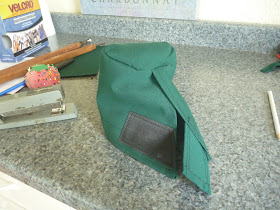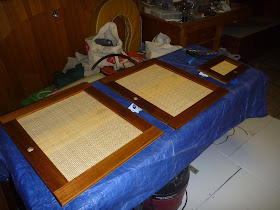The deck pipe does a great job of feeding the chain down below, but it's missing the chain cover plate so the hole allows water into the anchor locker when it rains.
 |
| Our Ideal Windlass and Deck Pipe |
 |
| The Missing Chain Cover |
I searched online for pattern ideas, and the best I could find was a reference to making a bonnet-like design. Since I've never made a bonnet before, I went with something a little closer to home and opted for a design more reminiscent of a winch cover. Not that I've ever made a winch cover (we're of the camp that they don't really need covers), but I used a similar design to make a cover for our binnacle compass.
 |
| Sunbrella compass cover |
The cover was really quite easy to make. Using a compass I drew a circle for the top, then added my seam allowances. The base was a trapezoid with the top measuring the circumference of my Sunbrella circle and the bottom the circumference of my teak riser, plus hem allowances. Unlike a winch or compass cover where the vertical seam is closed, I wanted this one open to fit around the anchor chain, so I needed to add enough for a finished hem. When sewn together, I wanted a slight overlap in the fabric with the flap facing aft, in case we get any deck wash over the bow. And I cut a separate piece of Sunbrella to sew a Velcro strap along the base edge of my cover to keep it in place and secure it under the chain.
 |
| Circle layout for the top |
 |
| Hem line marked and fabric notched to make it easer to sew around the curve |
 |
| Cut out for the base |
 |
| Velcro tab added to secure under the anchor chain. |
 |
| Deck pipe cover in place and ready for action |
 |
| Water leaks are a thing of the past |
A quick tip for those of you like me who use a lot of staples when you're sewing with Sunbrella or other canvas material. I like to keep a bottle opener on hand when working with canvas -- it makes staple removal a breeze and doesn't mar the fabric!












